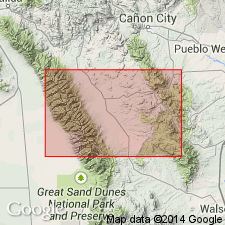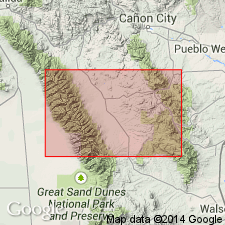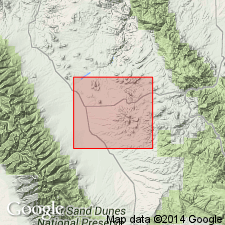
- Usage in publication:
-
- Rosita andesite*
- Modifications:
-
- First used
- Dominant lithology:
-
- Andesite
- AAPG geologic province:
-
- Las Vegas-Raton basin
Summary:
Probably named for town of Rosita in Custer Co. Is the earliest of the volcanic series forming the Rosita Hills, Custer Co, CO in the Las Vegas-Raton basin. No type locality designated. Chief occurrences are beneath and around town of Rosita. Is composed of hornblende-mica-andesite, locally containing a small amount of augite. Is predominately fragmental gray breccia and tuff with bodies of brown-purple massive rock. These rock types were the product of explosive volcanic action. Rosita exposures are uniformly decomposed. Succeeded by Bunker andesite. Is of Eocene age.
Source: GNU records (USGS DDS-6; Denver GNULEX).

- Usage in publication:
-
- Rosita Formation
- Modifications:
-
- Revised
- Redescribed
- Dominant lithology:
-
- Andesite
- Breccia
- Tuff
- Sandstone
- Conglomerate
- AAPG geologic province:
-
- Las Vegas-Raton basin
Summary:
Redefined to include some altered breccia, tuff, agglomerate around the Bassick mine in NW1/4 sec 21, T22S, R71W that Cross (1896) named Bassick Agglomerate. Cross was probably mislead by the hydrothermal alteration in Rosita and Bassick mine areas. Mapping (geologic map) for this study has shown Bassick to be part of Rosita. A type section designated in NW1/4 SW1/4 sec 14, T23S, R71W which is the best exposed, though not complete, section. Name changed from Rosita Andesite to Rosita Formation. Includes basalt, trachyandesite, trachyandesite breccia, tuff, tuffaceous sandstone, and conglomerate. Eastward the breccias are replaced by thin beds of pebble gravel consisting of gneiss, quartz, chert, pumice pebbles in a gray to yellow tuffaceous, sandy matrix. Bodies of porphyritic brecciated andesite occur around and north of Rosita; these may be the margins of flows or intrusions. Northward pyroclastic and epiclastic and breccias increase in number. Marker horizons rare. Ranges from 0 to 1,300 ft thick. Overlies an unnamed rhyolite ash-flow tuff in the Rosita Hills. May rest on rocks as old as Precambrian. Underlies unnamed rhyodacite in Rosita Hills. Has an isotopic age of 38.2 +/-1.5 m.y. (K-Ar) or late Eocene at Devils Hole. Eocene age.
Source: GNU records (USGS DDS-6; Denver GNULEX).

- Usage in publication:
-
- Rosita Andesite*
- Modifications:
-
- Age modified
- AAPG geologic province:
-
- Las Vegas-Raton basin
Summary:
Is part of early cycle (32 to 27 m.y. b.p. or Oligocene) of volcanic rocks at Rosita center, Custer Co, CO in Las Vegas-Raton basin. Bassick Agglomerate considered to be a phase of Rosita is therefore abandoned.
Source: GNU records (USGS DDS-6; Denver GNULEX).
For more information, please contact Nancy Stamm, Geologic Names Committee Secretary.
Asterisk (*) indicates published by U.S. Geological Survey authors.
"No current usage" (†) implies that a name has been abandoned or has fallen into disuse. Former usage and, if known, replacement name given in parentheses ( ).
Slash (/) indicates name conflicts with nomenclatural guidelines (CSN, 1933; ACSN, 1961, 1970; NACSN, 1983, 2005, 2021). May be explained within brackets ([ ]).

